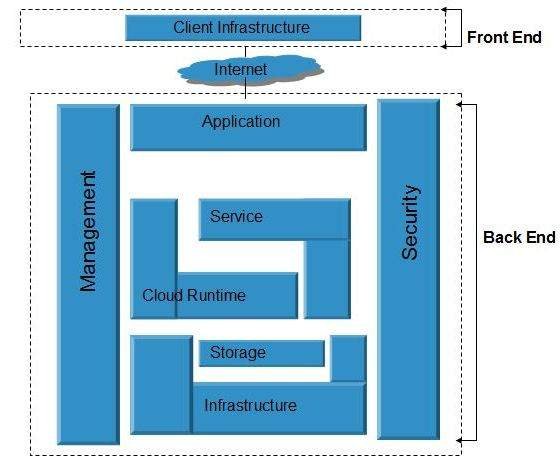What is Cloud Computing Architecture?
Let’s have a look into Cloud Computing and see what Cloud Computing is made of. Cloud computing comprises of two components front end and back end. Front end consist client part of cloud computing system. It comprise of interfaces and applications that are required to access the cloud computing platform.
While back end refers to the cloud itself, it comprises of the resources that are required for cloud computing services. It consists of virtual machines, servers, data storage, security mechanism etc. It is under providers control.
Cloud computing distributes the file system that spreads over multiple hard disks and machines. Data is never stored in one place only and in case one unit fails the other will take over automatically. The user disk space is allocated on the distributed file system, while another important component is algorithm for resource allocation. Cloud computing is a strong distributed environment and it heavily depends upon strong algorithm.
Diagram of Cloud Computing Architecture
Note: Cloud Architecture and Cloud Infrastructure both have different components and concepts. Cloud Architecture describes a high-level overview of client and server communication via network whereas Cloud Infrastructure tells about the servers, storage, virtualization, and various services.
- As depicted the cloud architecture consists of Front End and Back End both. Therefore, the first thing that comes into our mind is what is this or how this architecture is solving our complex resource sharing problem
- Let’s walk through this architecture, client-side or the front end will be like meeting with the web applications or the interfaces of the applications having the protocols and ports configured for accessing and interaction between the user and database or we can say cloud computing platform. E.g. Web Browser.
- Back End refers to the cloud itself. It comprises of resources providing cloud computing services. It consists of all the necessities like big data storage, security, virtual machines.
- All applications being hosted on the back end of the cloud premises are secured because of the built-in security of the mechanism, traffic control, and protocols.
- These Protocols are the mediators or the middle ware to establish successful communication with each other.
- If we bring our focus into the cloud infrastructure which has all abilities of server management, hypervisor, network, server, and storage will provide a good aid to the entire project i.e. it is very good for project management.
- It has a concept of hypervisor which plays quite a pivotal role in the sense, it helps in creating a lot many micro services without providing the entire load on the Operating system.
Do you know How Cloud Computing Works?
i. Front End
The front end is the client part of Cloud Computing which uses as per the requirement of the user. Front-end comprises of the applications and the interfaces which help to access the cloud computing. Example- Browser or an app created by the company itself.
ii. Back End
The back end is a part which manages by the allotted authorities of the company and their back end has large data storage facilities, Virtual machines, security system, and servers. They are also engaged in traffic management along with security management.
Components of Cloud Computing Architecture
Let’s discuss some components of Cloud Computing Architecture:
i. Hypervisor
The hypervisor is also known as Virtual Machine Monitor. This consists of the software, hardware, and firmware which makes and runs the virtual machines. The Hypervisor provides a user with a platform which is known as Virtual Operating Platform. This allows us to manage the guest’s operating system to use the cloud. This can be also known as the traditional term of the kernel in an operating system.
ii. Management Software
Management software consists of various plans and the strategies which help to increase the performance of the cloud. This management software provides many features such as on-time delivery of storage, proper security, all-time access, and many other facilities. This is one of the important parts of Cloud Computing architecture. One of the important features of this is the compliance auditing, management of overseeing disaster, and contingency plans.
iii. Deployment Software
Cloud deployment simply means to initiate the working of the SaaS, PaaS, and IaaS. This initiates the solutions that can access by the users or the customers. This deployment consists of all the mandatory installations and configurations of the cloud. This emerges from the back end and implements before the provisioning occurs.
iv. Route of Connectivity
It is an important part of the Cloud Computing architecture, through which the whole cloud gets connected. The speed of transfer depends on the network which is the internet connection. There are many cloud servers present which connects with the help of this virtual route. This also provides a facility to the user by allowing them to customize the route and protocol.
v. A server of the Cloud
A cloud server is a virtual server running in cloud computing premises. It’s engineered, hosted and delivered via a cloud computing platform via the web. It can be accessed from anywhere.
Cloud servers are stable, quick and secured. They avoid the hardware problems seen with physical servers, and that they are seemingly to be the foremost stable choice for businesses. Also, call as virtual servers. Cloud servers have all the software they need to run and can operate as non-dependent units. It also has the profit because it is incredibly simple and fast to upgrade by adding memory and disk space, further as being more cost-effective.
vi. Storage of the Cloud
Cloud storage service, construct to produce applications, services and organizations with access to offsite storage capability that may provision instantly are versatile in scaling automatically at runtime and is globally accessible. An Infrastructure as a Service (IaaS) service model delivers scalable, flexible and redundant storage capability through net services API, online interfaces and thin client applications.
